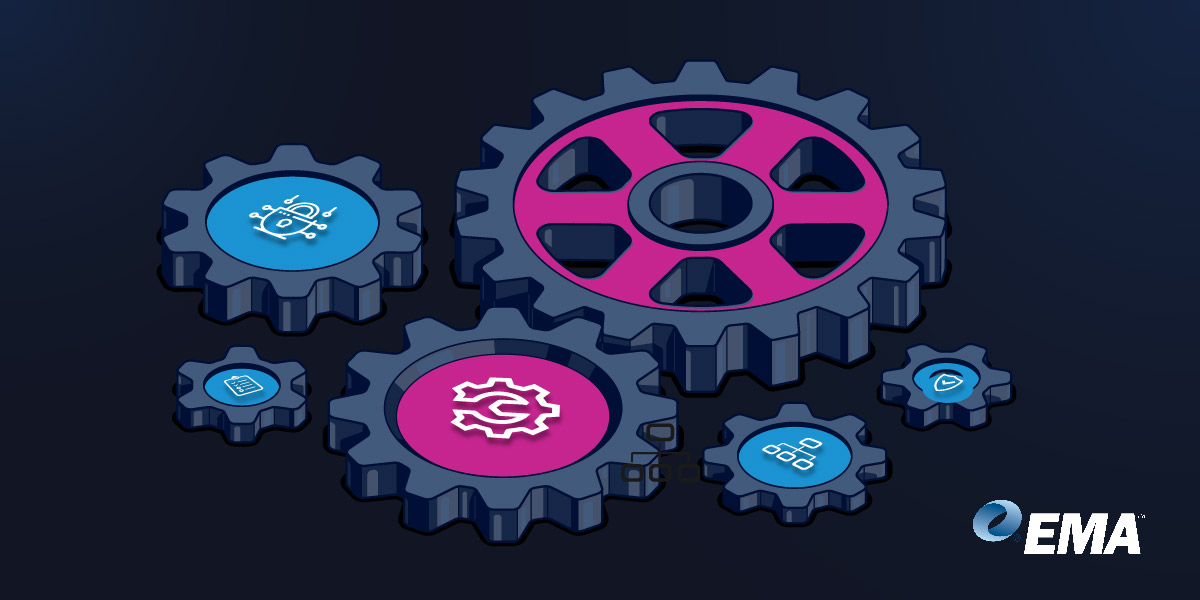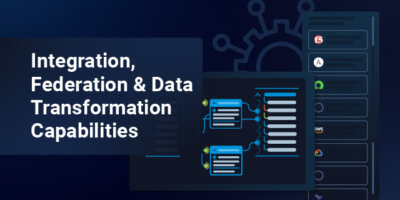“IT organizations recognize that there isn’t one tool that can solve the entire problem. Instead, they need a portfolio of tools — but what makes a successful network automation tool portfolio?” – EMA.
The March 2024 report Enterprise Network Automation: Emerging From the Dark Ages and Reaching Toward NetDevOps by EMA (Enterprise Management Associates) offers an in-depth exploration of network automation drivers, strategies, and solution requirements. One major trend identified by the report is a clear need for integration across a variety of tools to drive operational efficiency and compliance across complex network infrastructure.
As per the report, EMA “has consistently found that IT organizations cobble together a mix of homegrown, open source, and commercial tools to automate their networks.” The question is, how can organizations tie automation tools together and integrate them with other IT systems to turn complexity into efficiency?
Distributed Automation, Distributed Infrastructure
Networks are distributed across traditional infrastructure domains and multiple cloud environments (private and public). To automate across this multi-domain, multi-cloud complexity, teams leverage a variety of tooling to build different single-purpose scripts that automate domain-specific tasks. Data center teams will use different tooling to security teams who use different tooling to cloud teams and so on.
This can create challenges for IT organizations, which are often looking to adopt automation across as many domains as possible. Automating a task within a domain and orchestrating a process across multiple domains are two very different things.
See this chart from the EMA report, asking which domains are the primary focus of organizations’ network strategies:
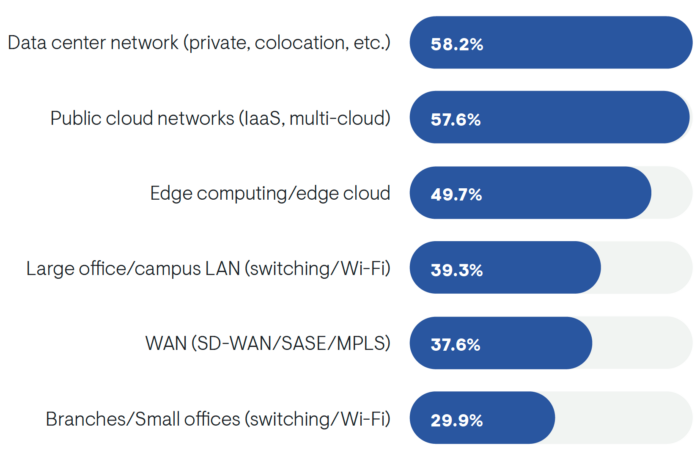
Source: EMA Report: Enterprise Network Automation: Emerging From the Dark Ages and Reaching Toward NetDevOps
Data center networks, public cloud, and edge deployments proved the three highest-priority domains for automation initiatives in EMA’s survey data. But the rest were not so far behind that they can be ignored. One engineer quoted in the report put it very plainly: “We are automating everything. There is nothing we won’t automate.”
Organizations are interested in expanding automation to deliver efficiency in every part of the network, accelerating service delivery and compliance across complex infrastructure while driving key business goals like tooling flexibility and accelerated application development.
Expanding automation from single-domain tasks to multi-domain processes involves integrating multiple domain-specific automation tools along with other systems such as security platforms, IPAM and inventory, ITSM/change management platforms, instant messaging, and any other IT systems an organization uses to drive work, communicate, and expose infrastructure services.
This chart from the EMA report asks for the most challenging technical issues for organizations’ automation strategies:
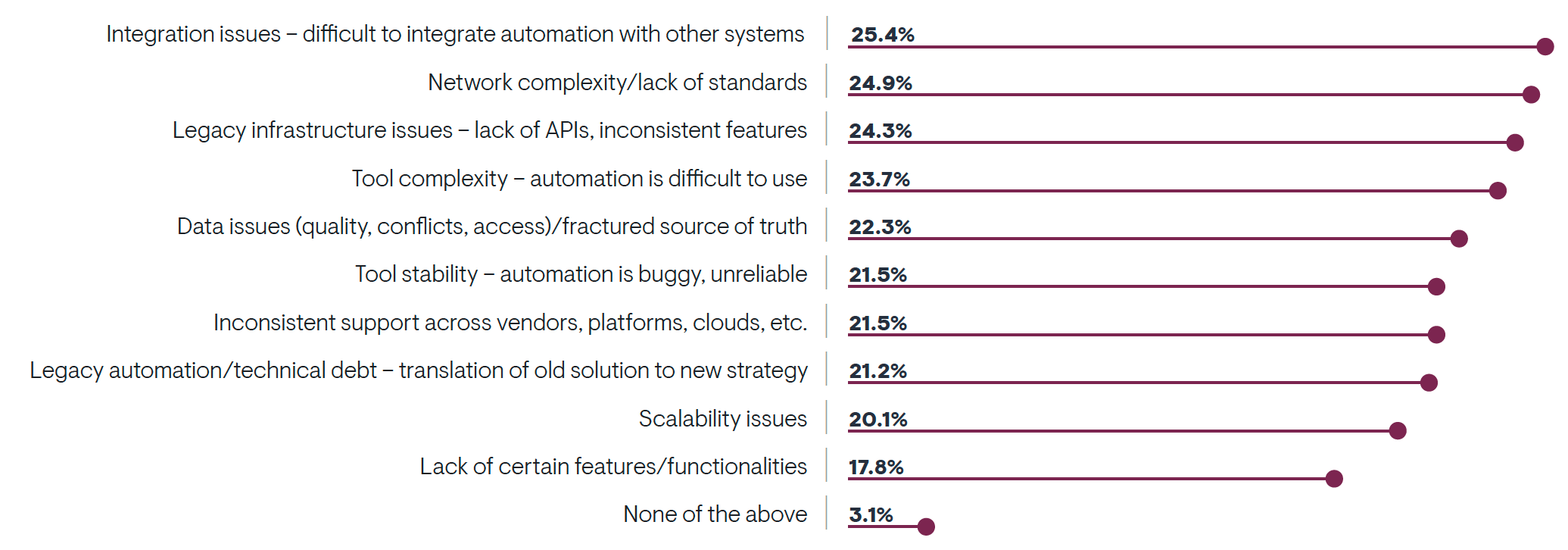
Source: EMA Report: Enterprise Network Automation: Emerging From the Dark Ages and Reaching Toward NetDevOps
With integration issues listed as the top challenge, it’s clear that organizations must find ways to tie multiple automation tools and multiple IT systems together more efficiently to drive network automation success.
Integrate Network Automation With Key Systems for Success
Network automation tools are part of an ecosystem of solutions.
They’re a lot like any other IT management systems in that way. IT organizations are always looking to increase the value they get from their tooling by integrating IT management with other systems to exchange data, trigger infrastructure changes, and extend capabilities across the organization.
The EMA report’s survey data shows that organizations are prioritizing three areas for integration to enable network automation success:
- IT service management.
- Security monitoring.
- Cloud and data center infrastructure management tooling.
In addition, many are also prioritizing integrating network automation tooling with performance management and security policy management systems. See the chart below ranking which systems the surveyed organizations said were priorities for integrating with network automation:
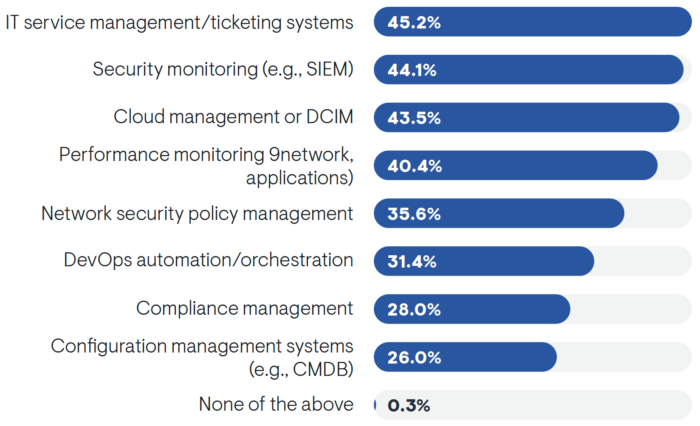
Source: EMA Report: Enterprise Network Automation: Emerging From the Dark Ages and Reaching Toward NetDevOps
While some systems are prioritized by a larger group than others, the fact that only 0.3% answered ‘None of the Above’ shows that integrating network automation with some combination of IT systems is a key priority for almost every enterprise network team.
As the EMA report states, in network automation, “there is not one tool that addresses every requirement an IT organization has.” Organizations leverage a variety of automation tooling and a variety of IT systems to manage their infrastructure.
By integrating network automation with different systems, organizations can expand and extend automation in new ways, such as coupling network changes with security rule queries, automatically managing tickets as network change processes are executed, and orchestrating processes across both cloud and on-premises environments. The ability to automate and orchestrate effectively across everything in the network will deliver transformative benefits.
How Itential Enables Teams to Rapidly Integrate Network Automation With Their Ecosystem
Itential’s unique approach to integration with network automation tooling, network devices and services, and IT systems makes it the best solution for organizations to transform and extend their automation strategies. Our patented, API-driven integration model provides a robust framework for network automation success.
The primary strength of our approach to integration is its flexibility. Unlike other approaches, Itential doesn’t require custom services or resources to build new integrations for each new platform or custom-built system. Instead, the platform leverages API documents to allow users to rapidly auto-generate integrations to systems and platforms across the network. In addition, a large ecosystem of pre-built integrations available on Itential’s Automation Marketplace helps teams move even faster.
On top of this, Itential has the ability to onboard network automation scripts built with a variety of tooling (Python, Ansible, OpenTofu, etc.) and attach API endpoints to them through the use of Itential Automation Gateway.
These capabilities mean a user of the Itential Automation Platform can onboard any network automation script and integrate with any systems across all domains to orchestrate a change process end-to-end, including ticket management, security steps, validation, and querying sources of truth. It’s the most effective version of network automation — removing as many manual touches as possible by turning manual processes into orchestrated workflows.
According to the report, “EMA believes that the future of network automation is an ecosystem of tools and products that must integrate to provide a fully effective solution.” In practice, this means adopting the right tools for individual jobs, and then leveraging a platform like Itential that can tie everything together and provide a centralized framework for efficient network orchestration.
You can dive into the full EMA report here if your organization has a license. To learn how Itential’s integration ecosystem can power the next phase of your network automation strategy, see here.

